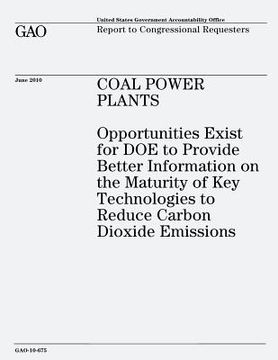Coal Power Plants: Opportunities Exist for DOE to Provide Better Information on the Maturity of Key Technologies to Reduce Carbon Dioxide (en Inglés)
Reseña del libro "Coal Power Plants: Opportunities Exist for DOE to Provide Better Information on the Maturity of Key Technologies to Reduce Carbon Dioxide (en Inglés)"
Coal power plants generate about half of the United States' electricity and are expected to remain a key energy source. Coal power plants also account for about one-third of the nation's emissions of carbon dioxide (CO2 ), the primary greenhouse gas that experts believe contributes to climate change. Current regulatory efforts and proposed legislation that seek to reduce CO2 emissions could affect coal power plants. Two key technologies show potential for reducing CO2 emissions: (1) carbon capture and storage (CCS), which involves capturing and storing CO2 in geologic formations, and (2) plant efficiency improvements that allow plants to use less coal. The Department of Energy (DOE) plays a key role in accelerating the commercial availability of these technologies and devoted more than $600 million to them in fiscal year 2009. Congress asked GAO to examine (1) the maturity of these technologies; (2) their potential for commercial use, and any challenges to their use; and (3) possible implications of deploying these technologies. To conduct this work, GAO reviewed reports and interviewed stakeholders with expertise in coal technologies. DOE does not systematically assess the maturity of key coal technologies, but GAO found consensus among stakeholders that CCS is less mature than efficiency technologies. Specifically, DOE does not use a standard set of benchmarks or terms to describe the maturity of technologies, limiting its ability to provide key information to Congress, utilities, and other stakeholders. This lack of information limits congressional oversight of DOE's expenditures on these efforts, and it hampers policymakers' efforts to gauge the maturity of these technologies as they consider climate change policies. In the absence of this information from DOE, GAO interviewed stakeholders with expertise in CCS or efficiency technologies to identify their views on the maturity of these technologies. Stakeholders told GAO that while components of CCS have been used commercially in other industries, their application remains at a small scale in coal power plants, with only one fully integrated CCS project operating at a coal plant. Efficiency technologies, on the other hand, are in wider commercial use. Use of both technologies is, however, contingent on overcoming a variety of economic, technical, and legal challenges. In particular, with respect to CCS, stakeholders highlighted the large costs to install and operate current CCS technologies, the fact that large scale demonstration of CCS is needed in coal plants, and the lack of a national carbon policy to reduce CO2 emissions or a legal framework to govern liability for the permanent storage of large amounts of CO2. With respect to efficiency improvements, stakeholders highlighted the high cost to build or upgrade such coal plants, the fact that some upgrades require highly technical materials, and plant operators' concerns that changes to the existing fleet of coal power plants could trigger additional regulatory requirements. CCS technologies offer more potential to reduce CO2 emissions than efficiency improvements alone, and both could raise electricity costs and have other effects. Most stakeholders told GAO that CCS would increase electricity costs, and some reports estimate that current CCS technologies would increase electricity costs by about 30 to 80 percent at plants using these technologies. DOE has also reported that CCS could increase water consumption at power plants. Efficiency improvements offer more potential for near term reductions in CO2 emissions, but they cannot reduce CO2 emissions from a coal plant to the same extent as CCS. GAO recommends that DOE develop a standard set of benchmarks to gauge and report to Congress on the maturity of key technologies. In commenting on a draft of this report, DOE concurred with our recommendation.

